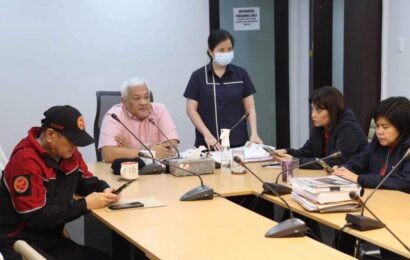
CABANATUAN CITY (PIA) — The Department of Health (DOH) is implementing various measures for Central Luzon to remain malaria-free.
These include conducting surveillance for active and passive case detection, providing free microscopy and rapid diagnostic test for diagnosis, and offering free full doses of antimalarial drugs for mild and severe cases.
DOH Central Luzon Center for Health Development Infectious Disease Cluster Health Program Officer Marlon Santos said they also distribute insecticidal nets and insecticides for indoor residual spraying, conduct health promotion activities and training sessions related to malaria, and offer technical assistance to public and private institutions.
“We also recommend protective measures such as wearing long clothing and using insect repellent, maintaining clean environments to eliminate mosquito breeding grounds, using insecticide-treated nets, and allowing indoor residual spraying with insecticides,” he added.
Santos likewise urged individuals experiencing symptoms of malaria, especially those with a history of travel abroad or belonging to at-risk populations, to consult a doctor immediately, particularly if they have visited a malaria-prone area.
Central Luzon was declared malaria-free last year.
“Bataan was the first to be declared in 2017 followed by Bulacan and Pampanga in 2018, Tarlac in 2019, Aurora in 2022 and finally Nueva Ecija and Zambales in 2023,” he disclosed.
Despite the good news, DOH has stressed the importance of remaining vigilant as reintroducing the disease is a potential risk that must be avoided.
“Even if we are malaria-free, we should not disregard the disease. We still need to know what malaria is and how to prevent it,” Santos pressed.
Malaria is a disease caused by a parasite transmitted to humans by female Anopheles mosquitoes, which breed in slow-moving, partly shaded-clear streams.
Santos noted that these mosquitoes are commonly found in remote areas, forests, and mountainous parts of provinces.
“Malaria can also be transmitted through blood transfusion, sharing of IV needles, and from the placenta of pregnant women. Pregnant women are at risk because if they contract malaria, they can pass the disease to the fetus through the bloodstream,” he added.
Classic symptoms include fever, chills, and sweating, typically appearing within 10 to 15 days after being bitten by an infected mosquito.
However, if not promptly treated, malaria can lead to severe symptoms such as loss of consciousness or convulsion, changes in movements, difficulty breathing, frequent vomiting and dizziness, jaundice, dark urine, and paleness or anemia.
“Malaria can be prevented and has appropriate treatment. But if left untreated, it can be fatal for individuals with malaria,” he warned.
World Malaria Day is observed every April 25.
SOURCE: Maria Asumpta Estefanie C. Reyes PIA3





